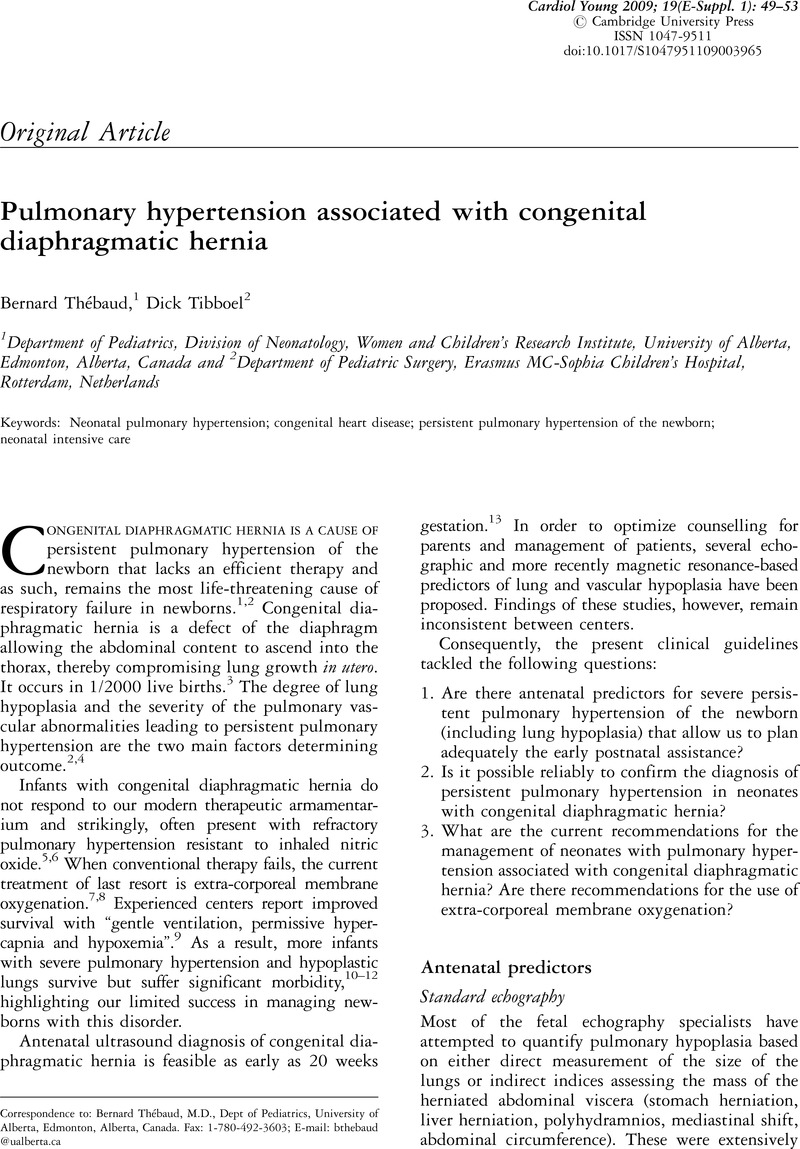Crossref Citations
This article has been cited by the following publications. This list is generated based on data provided by Crossref.
de Waal, Koert
and
Kluckow, Martin
2010.
Functional echocardiography; from physiology to treatment.
Early Human Development,
Vol. 86,
Issue. 3,
p.
149.
Safavi, Arash
Lin, Yi
and
Skarsgard, Erik D.
2010.
Perinatal management of congenital diaphragmatic hernia: when and how should babies be delivered? Results from the Canadian Pediatric Surgery Network.
Journal of Pediatric Surgery,
Vol. 45,
Issue. 12,
p.
2334.
Albert, Dimpna C.
del Cerro, María Jesús
Ignacio Carrasco, José
and
Portela, Francisco
2011.
Actualización en cardiología pediátrica y cardiopatías congénitas: técnicas de imagen, hipertensión arterial pulmonar, tratamientos híbridos y quirúrgicos.
Revista Española de Cardiología,
Vol. 64,
Issue. ,
p.
59.
del Cerro, Maria Jesus
Abman, Steven
Diaz, Gabriel
Freudenthal, Alexandra Heath
Freudenthal, Franz
Harikrishnan, S.
Haworth, Sheila G.
Ivy, Dunbar
Lopes, Antonio A.
Raj, J. Usha
Sandoval, Julio
Stenmark, Kurt
and
Adatia, Ian
2011.
A Consensus Approach to the Classification of Pediatric Pulmonary Hypertensive Vascular Disease: Report from the PVRI Pediatric Taskforce, Panama 2011.
Pulmonary Circulation,
Vol. 1,
Issue. 2,
p.
286.
Andropoulos, Dean B.
and
Gottlieb, Erin A.
2012.
Anesthesia and Uncommon Diseases.
p.
75.
Safavi, Arash
Synnes, Anne R.
O'Brien, Karel
Chiang, Monping
Skarsgard, Erik D.
and
Chiu, Priscilla P.L.
2012.
Multi-institutional follow-up of patients with congenital diaphragmatic hernia reveals severe disability and variations in practice.
Journal of Pediatric Surgery,
Vol. 47,
Issue. 5,
p.
836.
Jesús del Cerro, María
Abman, Steven
Díaz, Gabriel
Heath Freudenthal, Alexandra
Freudenthal, Franz
Harikrishnan, S.
Haworth, Sheila G.
Ivy, Dunbar
Lopes, Antonio A.
Usha Raj, J.
Sandoval, Julio
Stenmark, Kurt
Adatia, Ian
and
Lammers, Astrid E.
2012.
Consenso sobre la clasificación de la enfermedad vascular pulmonar hipertensiva en niños: Reporte del task force pediátrico del Pulmonary Vascular Research Institute (PVRI) Panamá 2011.
Revista Colombiana de Cardiología,
Vol. 19,
Issue. 6,
p.
339.
Ivy, D. Dunbar
Abman, Steven H.
Barst, Robyn J.
Berger, Rolf M.F.
Bonnet, Damien
Fleming, Thomas R.
Haworth, Sheila G.
Raj, J. Usha
Rosenzweig, Erika B.
Schulze Neick, Ingram
Steinhorn, Robin H.
and
Beghetti, Maurice
2013.
Pediatric Pulmonary Hypertension.
Journal of the American College of Cardiology,
Vol. 62,
Issue. 25,
p.
D117.
Sluiter, Ilona
van der Horst, Irene
van der Voorn, Paul
Boerema-de Munck, Anne
Buscop-van Kempen, Marjon
de Krijger, Ronald
Tibboel, Dick
Reiss, Irwin
and
Rottier, Robbert J.
2013.
Premature differentiation of vascular smooth muscle cells in human congenital diaphragmatic hernia.
Experimental and Molecular Pathology,
Vol. 94,
Issue. 1,
p.
195.
Moenkemeyer, Florian
and
Patel, Neil
2014.
Right Ventricular Diastolic Function Measured by Tissue Doppler Imaging Predicts Early Outcome in Congenital Diaphragmatic Hernia.
Pediatric Critical Care Medicine,
Vol. 15,
Issue. 1,
p.
49.
Weidner, M.
Zöllner, F. G.
Hagelstein, C.
Zahn, K.
Schaible, T.
Schoenberg, S. O.
Schad, L. R.
and
Neff, K. W.
2014.
High temporal versus high spatial resolution in MR quantitative pulmonary perfusion imaging of two-year old children after congenital diaphragmatic hernia repair.
European Radiology,
Vol. 24,
Issue. 10,
p.
2427.
Shue, Eveline H.
Schecter, Samuel C.
Gong, Wenhui
Etemadi, Mozziyar
Johengen, Michael
Iqbal, Corey
Derderian, S. Christopher
Oishi, Peter
Fineman, Jeffrey R.
and
Miniati, Doug
2014.
Antenatal maternally-administered phosphodiesterase type 5 inhibitors normalize eNOS expression in the fetal lamb model of congenital diaphragmatic hernia.
Journal of Pediatric Surgery,
Vol. 49,
Issue. 1,
p.
39.
Russo, F. M.
Eastwood, M. P.
Keijzer, R.
Al‐Maary, J.
Toelen, J.
Van Mieghem, T.
and
Deprest, J. A.
2017.
Lung size and liver herniation predict need for extracorporeal membrane oxygenation but not pulmonary hypertension in isolated congenital diaphragmatic hernia: systematic review and meta‐analysis.
Ultrasound in Obstetrics & Gynecology,
Vol. 49,
Issue. 6,
p.
704.
Marulanda, Kathleen
Tsihlis, Nick D.
McLean, Sean E.
and
Kibbe, Melina R.
2021.
Emerging antenatal therapies for congenital diaphragmatic hernia-induced pulmonary hypertension in preclinical models.
Pediatric Research,
Vol. 89,
Issue. 7,
p.
1641.
Bhombal, Shazia
and
Patel, Neil
2022.
Diagnosis & management of pulmonary hypertension in congenital diaphragmatic hernia.
Seminars in Fetal and Neonatal Medicine,
Vol. 27,
Issue. 4,
p.
101383.
Russo, Francesca Maria
Da Cunha, Marina Gabriela Monteiro Carvalho Mori
Jimenez, Julio
Lesage, Flore
Eastwood, Mary Patrice
Toelen, Jaan
and
Deprest, Jan
2022.
Complementary Effect of Maternal Sildenafil and Fetal Tracheal Occlusion Improves Lung Development in the Rabbit Model of Congenital Diaphragmatic Hernia.
Annals of Surgery,
Vol. 275,
Issue. 3,
p.
e586.



